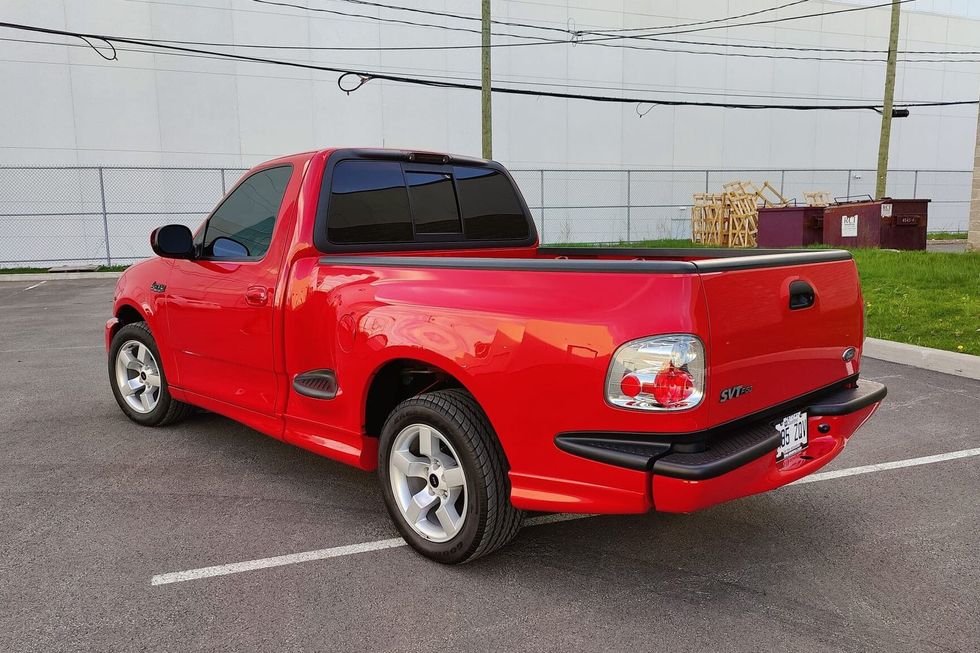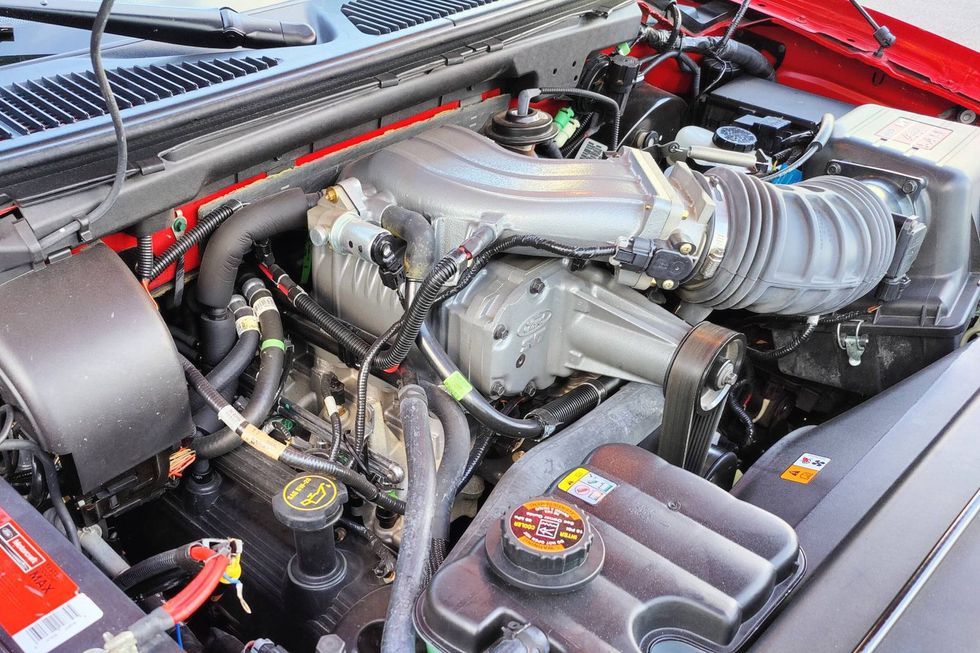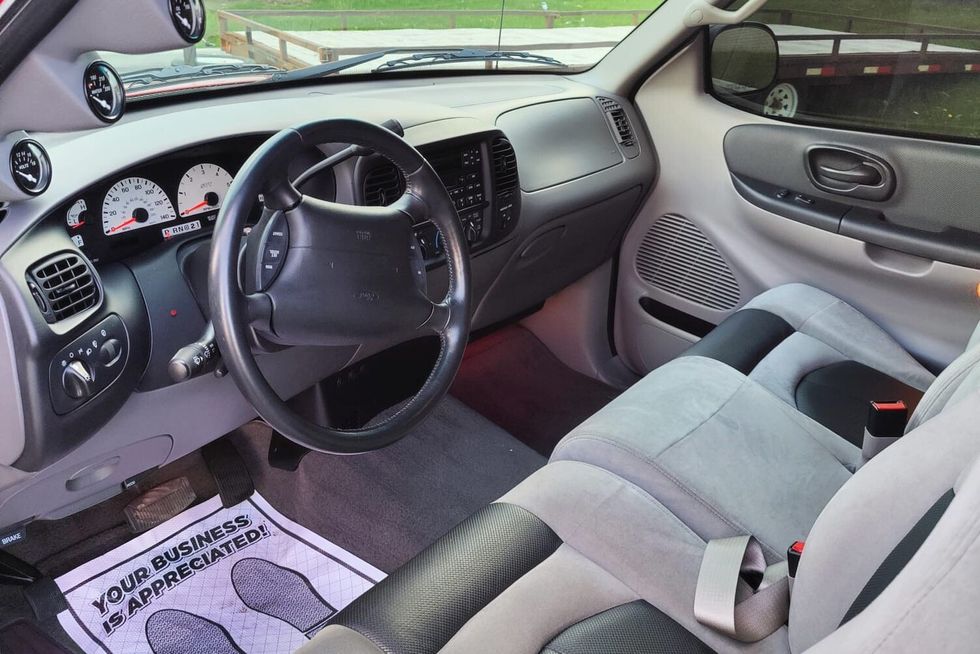Pure - 1964 Pontiac GTO
This everything-delete, Tri-Power '64 Pontiac GTO won the most comprehensive performance trials you've probably ever heard of
09/23/2018


Beyond all of the history written about the '64 Pontiac GTO, all of the stories of behind-the-scenes machinations meant to slide one past the GM board, all of the press manipulations, all of the topping of projected sales numbers and all of the emphasis on outright speed, there is another aspect to this historic machine that is often overlooked.
Oil companies--most notably Mobil, with its famed Economy Runs--often conducted independent testing, with the idea that participating manufacturers could boast about a victory in their ads, but these tests were often limited to a particular aspect of a car's performance. In contrast, the Pure Oil trials tested three separate real-world attributes: gas mileage on a single measured gallon of Pure Firebird gasoline was one part, but so were braking distances from 65 MPH after a series of progressive stops to heat up the drums, and passing power from a 25 MPH roll up to 70. A car that could do everything well was surely of more use in the daily slog of life than a pure feather-foot mileage test, no? Beyond corporate boasting in ads and at the dealership level, magazines from Motor Trend and Popular Science to the lesser-known, more targeted Modern Rod and USAS Autosports magazines covered the event--millions of readers would know of a good result. Even Chris Economaki's National Speed Sport News got in on reporting the trials.
For 1964, there were six different classes, each of which had cars within a prescribed cubic-inch range. Anything above 400 cubes was in Class I, for example; the 389-cube GTO on these pages ran in Class II. A new rule for 1964 demanded that vehicles in classes II through V be equipped with automatic transmission, as this was increasingly the transmission of choice among buyers of these cars.
Each participating manufacturer entered two cars per class, with the idea that an unusually good or unusually poor result in a given category could be averaged out. A total of 56 cars were prepared for the '64 Pure Oil trials, eight of them Pontiacs spread across four classes. Scoring was simple: The winner of a category would receive 10 points, second place received nine, and so on down the line. In the hotly contested Class II, with six manufacturers vying for points with 12 cars, multiple zeros were handed out to the class laggards. But this system also meant that, much like in several racing series we can think of, it was possible to amass plenty of points simply by being consistent, and thereby win at the end of the day.
Rather than deal with the variables of real-world testing, Pure Oil leveled the playing field by doing their testing at Daytona International Speedway; keep in mind that, before it was gobbled up by Union Oil Company in the mid-'60s, Pure Oil was the official gasoline of NASCAR, so it would only make sense that the trials would occur under the watchful eye of NASCAR officials on their ceremonial home turf.
The results show that the '64 event was something of a rout. Chevy won pretty much everything across the board--five of six categories outright, everything it entered, with the division consistently topping the charts thanks in part to its machines' strong braking abilities. (Who knew?) But with nothing in the 362-400 cube range, Chevy avoided Class II altogether. That left things wide open for two Ford divisions (Ford and Mercury), two Chrysler divisions (Plymouth and Dodge), and two GM divisions (Olds and Pontiac, which submitted a pair of GTOs).
That pair of GTOs, numbered 2-5 and 2-6 in the trials, were identically equipped, with a narrow range of features that you'd have to go out of your way to order. They were post coupes, as the bodies were marginally lighter; bucket seats lived inside, sans console. Radio? Deleted. Heater? Deleted. Wheel trims? Piepans. Differential? Still the standard 3.55, but it was open. And the mighty 348hp Tri-Power 389 was bolted to the only automatic Pontiac intermediates had that year--the column-shifted, two-speed M31 automatic, known to most as the Super Turbine 300. Manual steering and brakes, of course. The engine/trans combo, a tach, and transistorized ignition were the only options installed. Everything was as light as possible to aid in mileage and acceleration runs--no frou-frou consoles or any such fripperies. There wasn't even a door mirror, lest it generate wind resistance.
So bereft of goodies, you might wonder, why the Tri-Power engine? Simply, it played (in theory) to the strength of both the mileage and passing tests. Mash your foot to the floor, and 1.76 first gear or not, those six barrels waft the GTO from 25 to 70 MPH with alacrity. Yet with a gentle foot, keeping only the center two-barrel carburetor open, it had half a chance of doing well in the gas-mileage portion of the test as well.
And so it came to play out. The results were as follows: GTO number 2-5 scored 10 points for acceleration (5.855 seconds from 25-70), eight points for braking, and just three for fuel mileage--a total of 21 points. GTO number 2-6, the car seen in these pages, scored nine points for acceleration, and five each for braking and mileage--a total of 19 points. Combined, those 40 points trounced the Plymouth Savoy's 37, and were enough to give the Class II win to Pontiac. (It was also good enough to help Pontiac save some face in its Pure Oil endeavors: Pontiac representatives came in dead last in Class III and Class V--where one six-cylinder Tempest scored an appalling triple-zero--and was fourth out of five in Class I.)
Their appointed tasks completed, several dozen oddly-optioned cars needed to find new homes. The fate of these cars is generally unknown; no one paid much attention in those days. Maybe the manufacturer took 'em back and used them as mules on the proving grounds, maybe they wrote them off and crushed 'em, or maybe they were simply sold off as used cars, despite the weirdo options. GTO number 2-6, seen here, ended up on a used car lot in Ormond Beach, Florida, where the original owner picked it up as a daily driver.
Current owner Gordon Cowan was friendly with the original owner, and picks up the story. "The family was looking to trade in their '58 De Soto, and wanted a wagon, but the salesman didn't want to sell 'em one. He showed them this GTO, which was sold as a demo model since it had 3,000 miles on it at that point; he did tell them that it had run the Pure Oil Trials. They took it home overnight and liked it, so they bought it. The dealer had installed power steering, a heater, an AM radio, and an outside rearview mirror before they got it.
"I lived in Ormond Beach in 1985, and had for more than a year before I saw the '64 sitting in his driveway one night. I had a '67 at the time, so I walked over in the evening as he was siphoning gas out of it. It hadn't run in some time; he and a buddy had tried to put a timing chain in it some years back, to no avail. It looked like a nothing car--piepans, fuzzy steering wheel cover, column-shift automatic. Then he popped the hood and it was a Tri-Power--with transistorized ignition, no less. He told me it ran the Pure Oil Trials, which I thought was interesting--I was no expert, but I remember Pure Oil running them in the '60s. He'd tinker with it now and again, but never got it to run. We stayed in touch.
"Come 1991, he wanted to sell it, so he called and asked if I knew if anyone who would be interested. He reasoned, he was 72, he wasn't going to have the time to restore it, and he didn't have the know-how to do it right anyway. So I bought it. When we came to get it and put it on the trailer, he walked away wiping tears from his eyes. I showed him some of the information I'd found on the Pure Oil Trials, but he never did see the completed car."
Initially, Gordon tended to some mechanical issues: A new radiator replaced the disintegrating original, it got a fresh battery, and the corroded ignition amplifier case was restored back to new. "In the meantime, Pontiac Historic Services had just gotten up and running. So I got the build sheet from Pontiac, and what do you know, no radio, no this, no that. Later, Pete McCarthy and Pontiac engineer John Sawruk told me that the 2H on the data plate and the 584 code on the paperwork meant it was heater delete," Gordon reports.
The proof pointing toward this being number 2-6 is overwhelming. For starters, the Pontiac manifest for this car clearly delineates it as an engineering car--so right off the bat, it's an interesting piece. From some angles, in the right light, you can still see where the tape marking this as car number 2-6 was applied to the windshield; a periodic sandstorm blasted the rest of the windshield, leaving the taped-off areas protected. Daytona International Speedway even has photos of it during testing, with Buddy Baker behind the wheel; they sent Gordon a letter more or less confirming that his car was the real deal. "They told me that they get people asking all the time about Pace Cars and other cars that are alleged to have run at Daytona," he tells us. "The guys there at Daytona told me this is the first Pure Oil car they'd ever been asked about." The AC decals on each front fender are a testament to its running trim in Florida, nigh on half a century ago now.
When Gordon got it, the car's body was largely straight and rot-free; only the driver's side front fender needed to be replaced before a bare-metal strip and a complete Cameo Ivory re-spray. The 389 is now bored .030-inch over stock, and has received a complete balance-and-blueprint from Doug Hughes at Basko Machine in Gilbert, Arizona. They did change the linkage for the outboard carburetors from vacuum to mechanical, for drivability's sake, and Gordon also added a fan and shroud from an air-conditioning-equipped GTO--probably not a bad move, considering Phoenix regularly tops 110 degrees ambient temperature.
Basko also found some funny things when they went into the engine: "When NASCAR got the cars, they impounded them, and actually took the cars apart and checked that they matched AMA specifications. When we took that engine apart, the rods had been numbered--but were all put back in the wrong holes," Gordon says. "Same thing when I had the transmission done--the guy who did it told me, 'Boy, whoever went through here put it together all wrong.'" One could only have imagined the results had the NASCAR mechanics bothered to put things back correctly.
But the desire to add convenience options, to betray what made this car special to begin with, has been side-stepped in favor of authenticity to that which made this particular car a hero; the power steering, radio and heater are all gone, bringing the old Goat in line with its Pure Oil Trials specification. "All of the heater-delete-specific pieces were hard to locate, particularly the heater control cover for the dashboard," Gordon recalls. A dark blue Legendary interior has replaced most of the original interior. Also, "the tires were easiest to find, though they're not exact." The sandblasted windshield, it should be said, was left alone.
Today, the Pure Oil Trials are virtually forgotten; Pure was absorbed into Union Oil in 1965, and the trials stopped in 1970. It's not just the passage of time, either: Clearly news of the trials wasn't nearly as sexy as stuffing a 421 under the hood and sending it to a magazine to beat on for a week, and so the Pure Oil Trials have more or less disappeared from the consciousness of even the most die-hard car guys. As a test of a car's all-around suitability to the streets of America, however, the trials were far more comprehensive than some of the other, more famous tests of the time. It's worth remembering, and giving credit where due, to the fact that the GTO won, showing itself off not only as a fast car, but as an excellent all-rounder, perfect for American motoring needs--and fun besides.
Owner's View
I found this car in 1991 in the garage of my neighbor across the street; I loved the combination of oddball options, as well as its unique history. I was in the right place at the right time to purchase this car. I appreciate it for what it accomplished.
The toughest part of the restoration was getting the money to do it right; the rest was pretty straightforward. My greatest compliment came from the late Pontiac engineer John Sawruk, who told me, "This is a rare piece of Pontiac history."
-- Gordon Cowan
CLUB SCENE
GTO Association of America
www.gtoaa.org
Dues: $35/year • Membership: 4,000
Pontiac Oakland Club International
P.O. Box 68
Maple Plain, Minnesota 55359
877-368-3454
www.poci.org
Dues: $35/year • Membership: 8,800
PROS and CONS
PROS
+ Considered by many to be the genesis of muscle
+ More delete options than we thought could be deleted
+ Irreplaceable historical value
CONS
- Strange options (or lack thereof)
- There's only one to be had
- Two-speed automatic blunts Tri-Power's effectiveness
SPECIFICATIONS
Price
Base price -- $2,491 (Le Mans)
Options on car profiled -- GTO option, $295; Tri-Power engine, $115; Super Turbine 300 automatic transmission, $199.06; transistorized ignition, $75.27; tachometer, $54
Engine
Type -- Pontiac OHV V-8, cast-iron block and cylinder heads
Displacement -- 389 cubic inches (now 394-cu.in.)
Bore x Stroke -- 4.06 x 3.75 inches (now 4.09 x 3.75 inches)
Compression ratio -- 10.75:1
Horsepower @ RPM -- 348 @ 4,900
Torque @ RPM -- 428-lbs.ft. @ 3,600
Valvetrain -- Hydraulic valve lifters
Main bearings -- 5
Fuel system -- Three Rochester 2G/2GC two-barrel carburetors, mechanical Carter pump
Lubrication system -- Pressure, gear-type pump
Electrical system -- 12-volt
Exhaust system -- Dual exhaust
Transmission
Type -- GM Super Turbine 300 two-speed automatic, column shift
Ratios:
1st -- 1.76:1
2nd -- 1.00:1
Reverse -- 1.76:1
Differential
Type -- B-O-P 10-bolt housing
Ratio -- 3.55:1
Steering
Type -- Saginaw recirculating ball
Ratio -- 24:1
Turns, lock-to-lock -- 5.0
Brakes
Type -- Hydraulic, four-wheel manual drum
Front -- 9.82 x 2.50-inch drum
Rear -- 9.82 x 2.00-inch drum
Chassis & Body
Construction -- Perimeter frame with torque boxes
Body style -- Two-door pillared sedan
Layout -- Front engine, rear-wheel drive
Suspension
Front -- Independent, unequal-length A-arms; coil springs; telescoping shock absorbers
Rear -- Upper and lower control arms; coil springs; telescoping shock absorbers
Wheels & Tires
Wheels -- Stamped-steel, drop-center
Front -- 14 x 6 inches
Rear -- 14 x 6 inches
Tires -- U.S. Royal Safety 800 bias-ply
Front -- 14 x 7.50 inches
Rear -- 14 x 7.50 inches
Weights & Measures
Wheelbase -- 115 inches
Overall length -- 203 inches
Overall width -- 73.3 inches
Overall height -- 54 inches
Front track -- 54 inches
Rear track -- 54 inches
Shipping weight -- 3,388 pounds
Capacities
Crankcase -- 6 quarts
Cooling system -- 20.5 quarts
Fuel tank -- 21.5 gallons
Transmission -- 15 pints
Rear axle -- 3.75 pints
Calculated Data
BHP per cu.in. -- 0.894
Weight per BHP -- 9.73 pounds
Weight per cu.in. -- 8.70 pounds
Production
Pontiac produced 7,384 Model 2227 GTO post coupes for the 1964 model year.
Performance*
Acceleration:
0-60 MPH -- 6.6 seconds
1/4-mile ET -- 14.8 seconds @ 99 MPH
0-100 MPH -- 14.9 seconds
*Taken from a Car Life test in the June 1964 issue.
Memorial Day means the start of summer, and summer is road-trip season. What better choice is there for exploring new vistas and making new memories than a full-size American luxury car from the mid-'60s? These land yachts allow you to enjoy classic style without giving up niceties like air conditioning, cruise control, and power windows and seats. They're remarkably easy to drive, too, with their big, torquey V-8s, and fully capable of keeping up with modern traffic.
Detroit's Big Three were clicking on all cylinders when they created these cars, and the task of choosing among them hasn't gotten any easier over the past 60 years. Cadillac? Imperial? Lincoln? Each has its charms, and makes its own style statement. We picked these well-preserved examples from the Hemmings Marketplace, focusing on four-door sedans for the ultimate comfort of the passengers.
Did we leave out your favorite? If so, let us know in the comments. And if you're interested in reading more about classic American luxury cars, keep a lookout for the special feature in the July issue of Hemmings Motor News.
Photo: Hemmings Marketplace






Photo: Hemmings Marketplace






Photo: Hemmings Marketplace






Forget Ford’s groundbreaking electric truck for a moment to consider this 2001 Ford SVT F-150 Lightning now offered on Hemmings Auctions. Instead of the dual permanent-magnet motors found in the current electric Lightning, the 1999-2004 SVT Lightning featured a supercharged version of Ford’s 5.4-liter “modular” OHC V8. Rated at 380 horsepower in the 2001-’04 models, it was good enough to make a stock lightning a formidable opponent on the street as well as at the strip.
A follow-up to the original 1993-’95 F-150 Lightning, which was a high-performance version of a standard F-150, the second-generation SVT super truck presented as a more thoroughly developed model with a lot more exclusive components that further differentiated it from the rest of the F-Series lineup. Beyond the engine, the entire suspension and braking system, not to mention aerodynamic body add-ons, were part of the Lightning package from 1999 through 2004. Exclusive interior components were also part of the package.
At the heart of this SVT Lightning is its iron-block 5.4-liter SOHC, 16-valve V8 with a supercharger and an intercooler. The blower helped it deliver 380 horsepower and 450 lb-ft of torque in 2001, up some 20 horsepower and 10 lb-ft from the ’99 and 2000 models. The Eaton supercharged engine delivered peak boost of 8.0 psi and the engine featured an 8.4:1 static compression ratio, down from the standard 5.4 V8’s 9.0:1, which was rated at 260 horsepower and 350 lb-ft.
Power reached the rear 18-inch cast aluminum-alloy wheels via a four-speed automatic, an aluminum driveshaft and a beefy 9.75-inch, limited-slip rear axle with an acceleration-friendly 3.73:1 final-drive ratio, another upgrade for 2001. Car and Driver magazine reported a 0-60 mph time of 5.2 seconds and a quarter-mile in an E.T. of 13.8 seconds at 104 mph—impressive numbers for a 4,600-pound truck. Top speed was a drag-limited 142 mph.

Trucks generally require a suspension that can handle a full load in its bed while also providing competent driving while empty. But if you fancy one designed to a sports-car standard, then something has to give. In the case of the second-gen Lightning, Ford dropped its payload capacity to a mere 800 pounds. A standard 2001 F-150 Styleside carried a 3,180-pound payload rating, while an F-150 Flareside was rated at 2,005 pounds, some two-and-a-half times the Lightning, which featured the short-bed Flareside body. Towing capacity, likewise, was reduced from 8,800 pounds to 5,000 in the Lightning. But the Lightning’s strengths were never its payload or towing capacities, but it’s ability to perform like a sports car.
As a 21st century performance vehicle, however, the second-gen Lightning was also equipped to handle. A half-inch drop at the front was accompanied by SVT-specific coil springs and Bilstein shocks along with an exclusive 31-mm solid anti-roll bar. SVT’s influence continued at the rear with Lightning-specific five-leaf springs and a 23-mm solid anti-roll bar. The Bilstein setup at the rear included the right-rear shock staggered toward the front of the truck to reduce axle hop under heavy acceleration. The four-wheel antilock disc brakes were cribbed from the three-quarter-ton F-250, with 12.1-inch front rotors at the front and 13.1-inch discs at the rear.

As the years go on, fewer and fewer clean, unmolested low-mileage examples are out there, which is why this 2001 Ford SVT F150 Lightning now on Hemmings Auctions caught our attention. Showing just 5,525.5 miles on its odometer at the time of submission, it is said to be in “mint” condition and have an “immaculate” finish in the seller’s words. No modifications are noted to any part of the vehicle. The 18-inch factory alloys don’t appear to have any curb rash, though the Goodyear performance tires may be original. About the only deviations from stock are the tinted windows.
The latest electric-only F-150 Lightning is certainly a quick vehicle in its own right, but this 2001 edition from the engineers at SVT was built for excitement, not range. It was made with an old-school muscle-car vibe along with modern handling and braking. Which Lightning would you look good behind the wheel of?
Take a look at this second-gen Lightning on Hemmings Auctions before the bidding ends.
